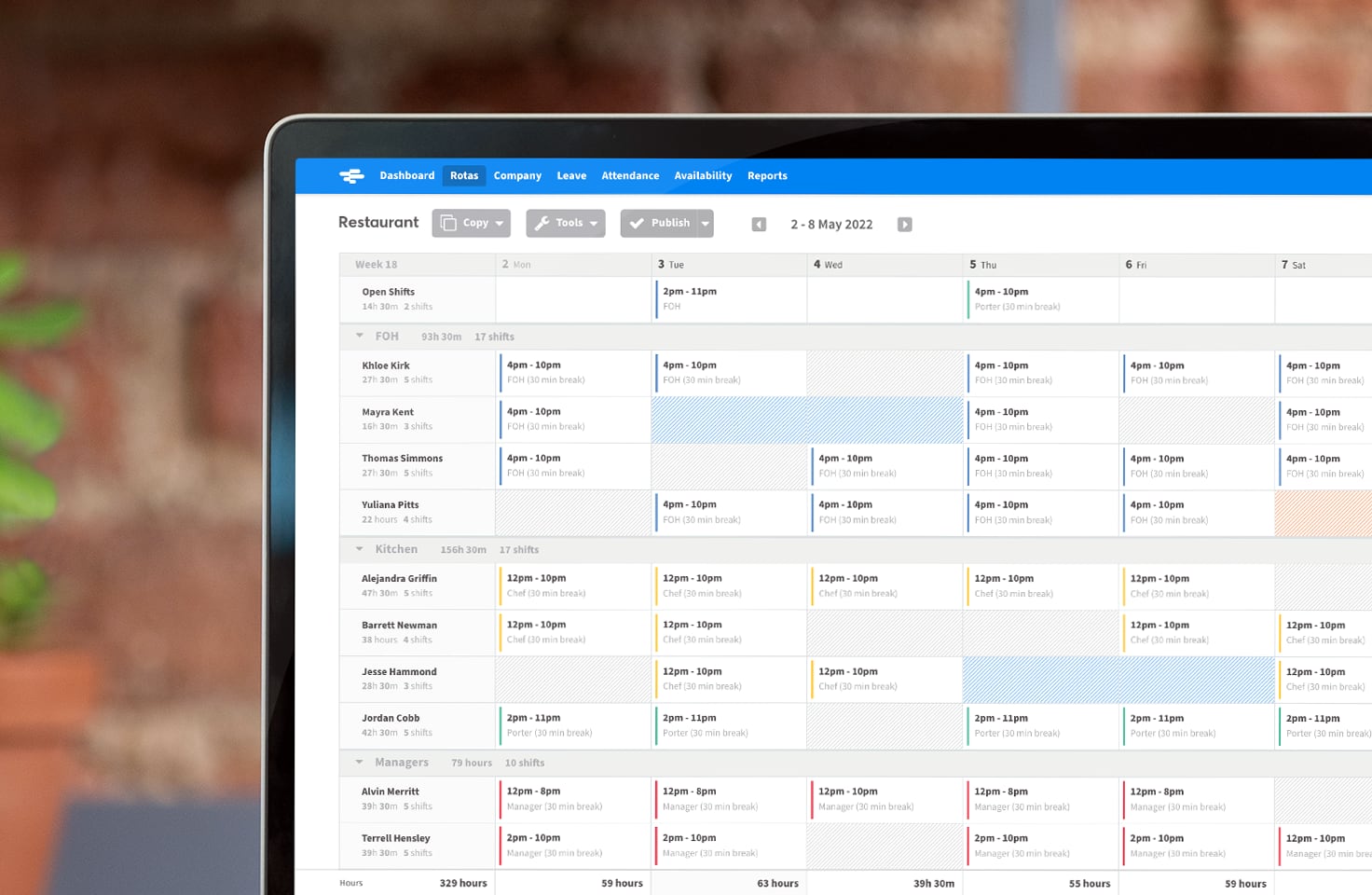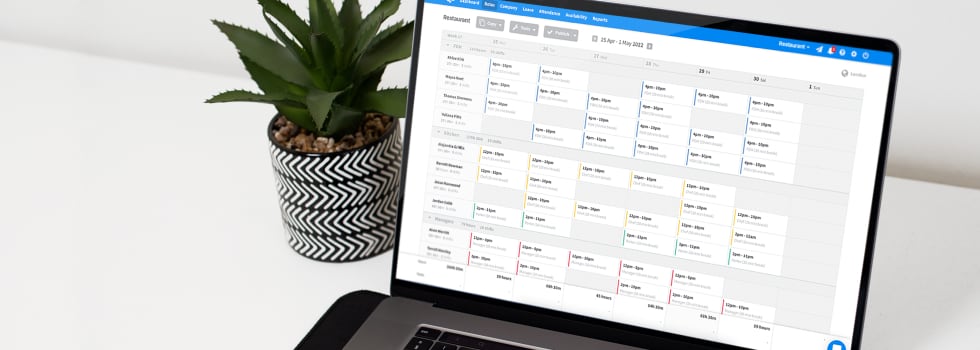We spoke to the team at RotaCloud to see how staff rostering software can keep teams sweet by reducing shift mix-ups and giving managers a clear view on how many hours people are working.
Who would have thought during the pandemic that staffing would be the hospitality industry’s principle headache as it edged back to something resembling normality? Yet here we are. A failure to tackle labour shortages — caused by a host of factors including Brexit and people being lost to other industries during the pandemic — is stifling the sector’s recovery.
According to a recent report by trade body UKHospitality the industry is about 400,000 bodies short of being fully staffed. That’s an awfully big number and an awfully big challenge for restaurants and the wider hospitality sector, which is now having to cut its cloth accordingly.
Despite strong demand, businesses are having to scale back expansion plans and reduce opening hours. Menus are also getting shorter, with operators reducing the total number of dishes in order to be able to deliver good food with fewer kitchen staff.
The staffing crisis is a complex issue with no single solution. A good start, though, is to make the lives of the staff you do have as stress-free as possible, and improve retention in the process. Business owners might not be able to help their employees navigate changes in their lives outside work, but they can do their very best to make the employee experience as consistent and hassle-free as possible.
Making life easier for shift workers

Rotas tend to be rather prescriptive documents. Unplanned absence and holidays aside, staff typically do the shifts they get and therefore have little say in how the rota is planned. More often than not, the reason for this is that managers don’t have time to consider fully the needs of their teams: as much as they would probably like to construct a rota that takes into account each staff member's personal commitments and schedule outside work, they simply don’t have the time to do so.
However, a lack of control over one’s work life is stressful, and can often be a contributing factor to the decision to leave a workplace. But technology can help. By utilising software that allows teams to easily and quickly communicate their availability — and that availability to be shown as rotas are constructed in real time — managers can more easily create a rota that works for the whole team.
Such an approach means that staff are less likely to request changes following the publication of the rota, which further reduces confusion and admin.
Rethinking shift patterns
Clearly those that design rotas know their businesses well and therefore have an understanding of where staff need to be placed. Yet they should also consider the effect shift patterns will have on the staff on the ground.
Venues should consider changing up shift patterns and analysing how this affects metrics including employee engagement, fatigue, and productivity over time. There’s no such thing as a one-size-fits-all approach, so those that plan rotas must be wary of copying other businesses or mimicking the same shift patterns — for example what works for the front of house team won’t necessarily work for the back of house team.
While busy managers might not like the idea of encouraging staff to take time off, research shows that staff who don’t make full use of their entitled annual leave are more likely to fall ill or exhibit signs of stress than those who do (they’re also more likely to have lower productivity).
With this in mind — and even during a staffing crisis — managers should do as much as they can to encourage staff to make full use of their annual leave.
The benefits of digital rotas
Paper and spreadsheet-based rotas remain commonplace yet generate a lot of admin, with managers having to manually distribute information regarding shifts through such low-tech means as screen-shotting a rota and sending it on WhatsApp. On top of this, the data is not ‘live’ meaning that changes can cause big headaches that result in confusing back-and-forths over WhatsApp and similar.
“Against the backdrop of the staffing crisis a digital approach to rotas makes a lot of sense,” says RotaCloud co-founder James Lintern. “First off, it saves managers a lot of time by dramatically reducing admin. But perhaps even more importantly, staff want to work in places that are organised.”
“Using a product such as RotaCloud can help streamline people’s lives and give them a bit more autonomy,” interjects RotaCloud’s workforce trends expert Brooke Curtis. “Digital rotas and staff management systems help contribute to a good employee experience, and should therefore be thought of as both a recruitment tool and a retention tool.”
Recent research from the Living Wage Foundation revealed that nearly a third of all UK workers in full or part-time employment are given less than a week’s notice of their shifts. “That’s not great,” continues Curtis. “But such situations can often be mitigated by using rostering software that allows staff to specify their availability patterns.”
Shift swaps and cover can also be arranged with the relevant people getting notified throughout each step of the process (managers get the final say, and the rota is updated automatically). Digital rotas also allow managers to see daily and weekly hours on the rota as they plan, to ensure hours are handed out fairly and staff aren’t being overworked.
“With automatic shift notifications sent out when the rota changes, rota planning software makes tweaking the rota much easier,” says Lintern. “You can adjust shifts based on employee requests, and you can even see how changes would affect your budget before committing to them.”
Ending admin headaches

For managers, the biggest benefit of digital rotas is that they eliminate common scheduling headaches such as confusion over whether staff are working a given shift, managers asking people to work on days they have already booked off and shift swapping (an endless source of workplace disputes, as anybody that’s ever worked in a restaurant will tell you).
Resolving these problems is something that most managers are resigned to having to put up with (indeed dealing with the fallout that results from scheduling mishaps is an everyday task for many).
But rota planning software eliminates these problems almost at once. Shift notifications and shift acknowledgement options mean staff are kept in the loop when their shifts change. Managers can see when team members have swapped shifts and all swaps are done through the software, meaning those overseeing can see a history of each shift to see who swapped with who (and when). You can also utilise ‘open shifts’ functionality, whereby free shifts can be offered to all staff automatically rather than having to resort to ringing around.
Clocking in
Another key scheduling software feature is the ability for staff to clock in and out of their shifts via either their smartphone or at fixed terminals. This ensures that staff are paid accurately for the hours that they work and is also a useful tool for managers to keep track of where their people are. The app is also able to notify staff if they are running late or have forgotten to clock in.
Rota software can manage absence too, including annual leave. In RotaCloud for example, staff can see their remaining allowance for the year and request holiday. This makes it far easier for employees to book time off, and helps to avoid a build-up of holiday at the end of the year – another common cause of headaches for managers - with holiday more likely to be taken steadily across the year.
Saving even more time
Tech solutions save managers a lot of time when it comes to planning rotas and dealing with the logistics of team management and operations. “This means more time spent developing your staff and growing your business,” says Lintern. “Our customers tell us time and time again that RotaCloud has freed up so much of their day that they can’t imagine life without it.” And from an employee perspective, having more advanced notice of when they're working, less shift mix-ups, and a generally smoother, more reliable experience with your business — scheduling software is an invaluable tool in the fight for staff retention.
RotaCloud


